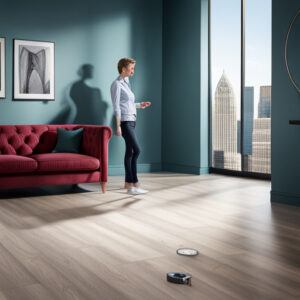Are you tired of finding unsightly marks on your floors after your Roomba has completed its cleaning cycle? Do you wonder if there’s a way to enjoy the convenience of a robotic vacuum without the risk of damaging your beautiful floors? In this blog post, we’ll explore a range of practical tips and solutions to help you prevent your Roomba from leaving marks on your floors.
We’ll delve into the factors that can contribute to floor marks, such as the type of flooring, the design of your Roomba, and the maintenance of its components. You’ll discover simple yet effective strategies to safeguard your floors, whether they’re hardwood, tile, or carpet. Additionally, we’ll discuss the importance of regular maintenance and adjustments to ensure that your Roomba operates smoothly without leaving any marks behind.
By the end of this post, you’ll be equipped with valuable insights and actionable advice to maintain the pristine condition of your floors while making the most of your Roomba’s cleaning capabilities. So, let’s dive in and say goodbye to floor marks for good!
Understanding Roomba Navigation Technology
Are you curious about how your Roomba moves around your home without getting stuck or leaving marks on the floor? Understanding the navigation technology behind your Roomba is essential for preventing floor marks and maintaining your floors’ pristine condition.
The navigation technology in Roombas consists of a combination of sensors, cameras, and algorithms that allow the device to map and navigate your home efficiently. These sensors help the Roomba detect obstacles, cliffs, and changes in floor surfaces to avoid collisions and damage.
By comprehending how your Roomba’s navigation system works, you can take proactive measures to prevent it from leaving marks on your floors. Furthermore, understanding the technology enables you to make informed decisions about the placement of virtual walls or barriers to protect sensitive areas.
Choosing the Right Cleaning Pads for Your Roomba
When it comes to preventing your Roomba from leaving marks on your floor, choosing the right cleaning pads is crucial. The type of cleaning pad you use can impact the effectiveness of your Roomba’s cleaning and the condition of your floors.
Microfiber cleaning pads are a popular choice for Roombas as they are gentle on floors and effectively pick up dust and debris. These pads are especially well-suited for hardwood, tile, and laminate floors.
For homes with pets, consider using cleaning pads specifically designed to pick up pet hair to prevent it from being spread around the house. These pads often have specialized textures to trap and remove pet hair effectively.
It’s important to regularly clean or replace the cleaning pads to maintain their effectiveness and prevent any accumulation of dirt or debris. Proper maintenance of the cleaning pads can help ensure that your Roomba continues to clean efficiently without causing any marks on your floors.
Tips for Maintaining Your Roomba’s Wheels
Regular maintenance of your Roomba’s wheels is essential to prevent marks on your floors. Start by checking the wheels for debris, hair, or any other foreign objects that could be causing the marks.
Use a damp cloth to clean the wheels thoroughly, removing any dirt or grime that may have accumulated. It’s also important to inspect the wheel treads for any buildup of dirt or hair that could affect their performance.
If you notice excessive wear and tear on the wheels, consider replacing them to ensure smooth operation and to prevent marks on your floors. Finally, remember to clean the wheels after each use to maintain the overall effectiveness of your Roomba.
Preventing Scratches and Scuffs on Hardwood Floors
When it comes to maintaining the pristine condition of your hardwood floors, preventing scratches and scuffs caused by your Roomba is essential. One of the key elements to consider in this regard is the maintenance of your Roomba’s wheels. Regular maintenance of the Roomba’s wheels is crucial to prevent marks on the floors.
This includes checking for debris, cleaning the wheels with a damp cloth, inspecting the wheel treads, and replacing worn-out wheels if necessary. Cleaning the wheels after each use is also important for maintaining the Roomba’s effectiveness. By keeping the wheels free of debris and ensuring that they are in good condition, you can minimize the risk of scratches and scuffs on your hardwood floors.
Conclusion: Ensuring Your Roomba Leaves No Marks
In conclusion, preventing your Roomba from leaving marks on your floor requires a proactive approach to understanding its navigation technology, maintaining its cleaning pads and wheels, and protecting your hardwood floors from scratches and scuffs. By implementing the tips and techniques discussed in this article, you can enjoy the convenience of a clean home without worrying about unsightly marks left by your Roomba.

